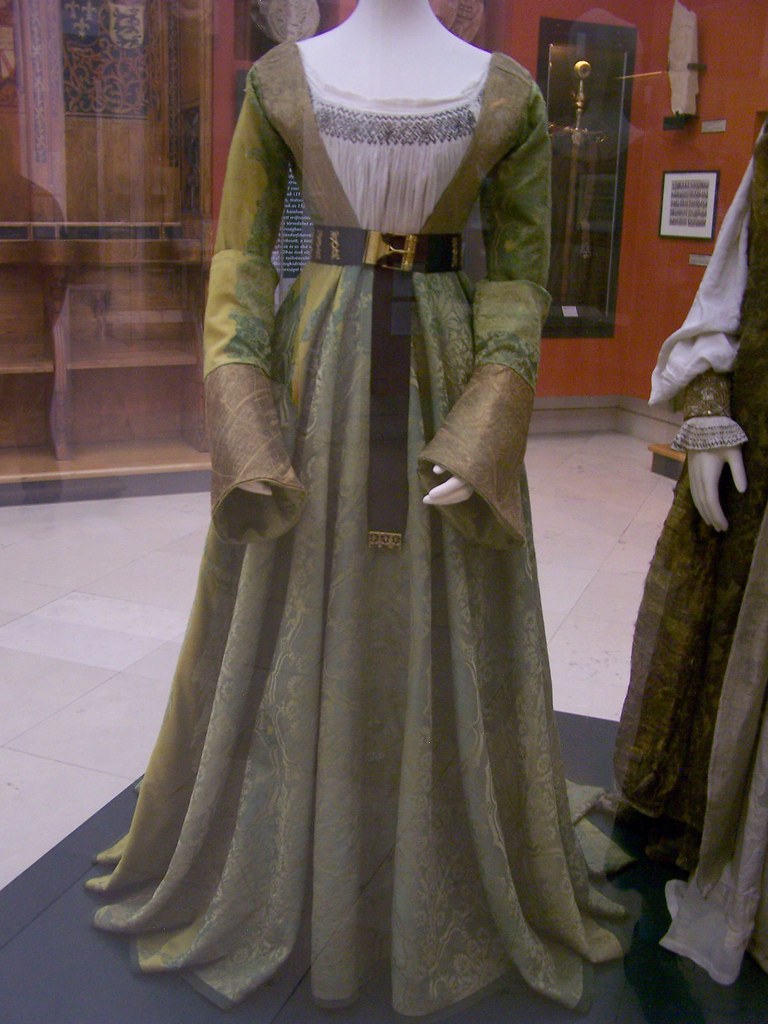I have said it in some previous posts, and maybe it's obvious if you read my latest post about 16th century working women, but my main project for the spring is a German renaissance gown. Early 16th century is my absolute favorite era in Swedish history, and there are quite a few interesting women around. One of the most fascinating is Kristina Gyllenstierna. She has quite a lengthy wiki-article, even if it's not particularly good. I'm really hoping that one day a modern historian will write a biography about her, unfortunately most of what's available about her is written pre-1950 and is steeped in nationalism and romanticism. Anyway if I want to make a gown based on what she could have worn that means a gown from the Swedish court, since she was queen in all but name, from around 1520. But what was Swedish court fashion back then?
This is actually the only available image of Kristina Gyllenstierna. It's not a portrait though, since it's on an altar piece that was produced in Antwerp, probably by an artist who had never seen her. Still it gives a good starting point of what was seen as fashionable at the time. And even if there might be differences in the fashion between Antwerp and Stockholm, they wouldn't have put the commisioner of the altar in something that was considered too outlandish. Still most of the gown is hidden under the cape, but at least you can that there is a voluminous skirt, a tight sleeve that goes all the way down to the hand, and to me the neckline looks more rounded than square.
Sweden at this time was dependent on the trade with Lübeck, and culturally integrated with northern Germany. So when lacking in portraits of Swedish women from around 1520 I instead chose to look at fashion from that area. I have put together at pinterest board with inspiration for the project, and here are some of the images
I love the gowns in the portraits of Lucas Cranach, they are after all even called Cranach gowns. This is Katarina of Mecklenburg, and Mecklenburg is a duchy on the Baltic coast, so it's within the area I'm looking for. Still this style is very much associated with the court of Saxony, which is a further bit south and Katarina was born as a duchess of Saxony. The defining parts of a Cranach gown to my eye seem to be the open bodice, with a lacing over a shift and the broad piece of embroidered cloth above the lacing, the "brusttuch", and crazily puffed and slashed sleeves. The sleeves on this gown aren't so crazy though.
This is a portrait of a young girl from Lübeck by Jacob van Utrecht and dated to 1520. Except for the colouration of the gown I liked the simple square neckline, and no lacing or brusttuch.
If I combine these three images I get a one coloured gown with a square neckline, a closed bodice and fairly tight sleeves, still I really want some slashing if I'm going to make German 16th century but I'm thinking just some slashing at the elbow, like the Cranach portrait above.
For the shift I will use the shift from Maria of Habsburg, also dated to 1520, as the main inspiration for the general shape.
I would prefer to have a shift with a high, smocked collar. When we start getting portraits of women from Sweden and Denmark in the late 1520s and 1530s this seems to have been the favoured shape. Just like with my 18th century shift I run into the practical problem of not having enough fabric. I have a piece of fine linen that I want to use and it's simply not enough to make that kind of shift. I will try and make it as high as possible, and hopefully I can get it up to the neck so it looks like the shift in this portrait of Isabella of Austria, queen of Denmark 1515-1523.
My plan for the spring is to make a shift, an undergown and a gown. If I have time, and a suitable fabric, I would like some kind of headwear. At this stage I'm not going to go for accurate 16th century shoes or hose, that will depend on what opportunities I will have to wear the gown.
So that's the inspiration for my 16th century project. Now since I do know that court gowns aren't the most practical and it can be hard to get any uses for them I am also planning to make a gown that is more fitting a woman from a lower class. I would still use the shift and undergown that I make for this project, but then I would make a gown in wool, which ironically would make it more expensive than what I'm planning for the court gown but that's the nature of being able to use stash instead of having to buy new, high quality materials.

.jpg/330px-Christina_Gyllenstierna_relief_2009_West_Aros_(crop).jpg)



This comment has been removed by a blog administrator.
ReplyDelete